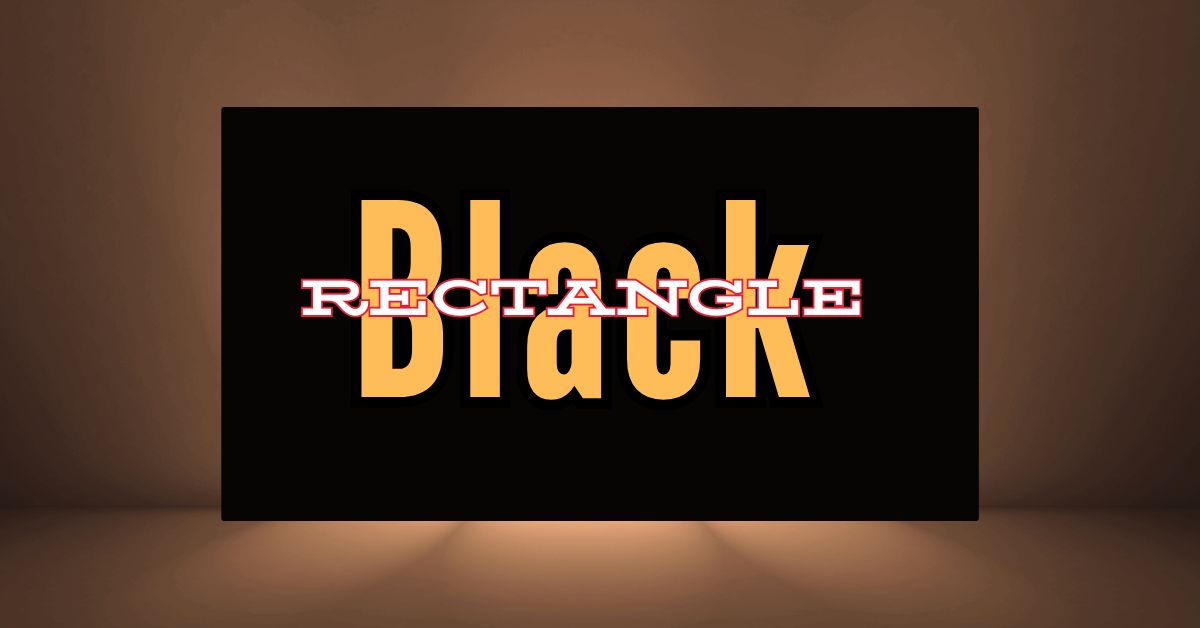The black rectangle may appear to be a simple shape, but it has played an extraordinary role in the world of art, design, and symbolism. From its place in modern art movements to its significance in geometric design, this shape is more than just a form—it’s a symbol, a concept, and a creative tool that has influenced countless artists and designers over the years. In this blog post, we’ll explore 5 fascinating facts about the black rectangle, its meaning, and why it remains relevant in today’s artistic and design landscapes.
What Is a Black Rectangle? A Look at Its Significance in Art
At its core, a black rectangle is simply a geometric figure, consisting of two pairs of parallel sides with right angles. Yet, in the realms of art and design, this straightforward form has taken on much deeper meaning. Often seen as a symbol of minimalism, structure, and abstraction, its clean edges convey a sense of order, while its stark black color adds an element of mystery or depth.
In modern artistic expressions, these rectangles are frequently used to challenge traditional concepts of representation. Instead of depicting recognizable objects or scenes, artists employ abstract shapes like the black rectangle to evoke emotion, provoke thought, or make bold statements about society, technology, or nature. The form has become a common element in both abstract and geometric art, allowing creators to communicate complex ideas through simple shapes.
The Meaning Behind the Black Rectangle: A Deep Dive Into Its Symbolism
The symbolism associated with this shape is diverse and complex, varying depending on context. In abstract art, it often represents structure, stability, and form. Its rigid, geometric nature contrasts with more organic shapes, making it a powerful representation of human-made order and industrialization. When used in art, it can convey themes of control, constraint, or even isolation.
However, the meaning is not always negative. In minimalist design, the black rectangle stands as a symbol of clarity and focus. By stripping away unnecessary details, it encourages viewers to concentrate on the essence of the composition, whether that’s a message, a feeling, or an idea. In this sense, this geometric form can also symbolize simplicity, purity, and directness.
For example, in Kazimir Malevich’s famous painting “Black Square,” this iconic shape was intended to symbolize pure artistic expression, free from the constraints of realistic representation. It marked a radical shift away from traditional painting techniques and remains one of the most recognized representations of abstract art.
Black Rectangles in Modern Art: Why Minimalism Matters
The use of black rectangles has become a cornerstone of minimalism, a movement that gained momentum in the mid-20th century. Artists like Donald Judd, Frank Stella, and Ad Reinhardt incorporated geometric shapes into their works to reduce art to its basic elements. This focus on form and structure was a reaction against the expressive and emotional excesses of earlier movements like Abstract Expressionism.
In minimalism, the black rectangle serves as a vehicle for exploring the relationships between space, form, and color. It embodies the idea that “less is more,” using simple shapes to provoke deep, complex reflections on art, life, and the human experience. As such, this shape represents a shift in artistic values, emphasizing clarity, precision, and the rejection of ornamentation.
One reason why these rectangles are vital in modern art is their ability to create a visual impact without needing representational imagery. The stark contrast allows viewers to focus on the relationship between elements, creating a powerful, almost meditative experience.
How the Black Rectangle Shape Has Influenced Design Trends
While the black rectangle has been central in the art world, it has also significantly impacted graphic design and architecture. The clean lines and simplicity of this shape have influenced many trends, especially in minimalist design, where functionality, clarity, and the removal of unnecessary elements are key.
In graphic design, this form is often employed to create a sense of order and hierarchy. Designers utilize it to frame content, organize layouts, and direct the viewer’s attention to crucial elements of a page or screen. The stark contrast of black against white or bright colors makes the rectangle stand out, guiding the viewer’s eye and creating a strong visual impact.
In web design and user interface design, these shapes frequently appear in buttons, banners, and navigation elements, providing a clear and easily recognizable structure that enhances the user experience. In print design, they are often used in logos, brochures, and posters to create clean, professional aesthetics.
The influence of the black rectangle isn’t limited to digital or graphic design. In architecture, the shape can be found in modern buildings, windows, and structural elements. Its clean, angular form allows for efficient use of space and materials, creating bold, striking visuals in the urban environment.
The History of the Black Rectangle in Abstract and Geometric Art
The history of the black rectangle in art can be traced back to the early 20th century, with the rise of abstract art and geometric abstraction. Kazimir Malevich, a Russian avant-garde artist, was a pioneer of Suprematism—an abstract art movement focused on basic geometric shapes like the square and rectangle.
Malevich’s “Black Square” (1915) is perhaps the most famous representation of this shape in art history. This work, consisting of a simple black square set against a white background, was revolutionary for its time. Malevich believed that geometric forms represented a higher reality, free from materialism and the physical world. His work inspired countless artists to explore abstraction and use geometric forms as the foundation of their creations.
Throughout the 20th century, artists such as Piet Mondrian, Josef Albers, and Ellsworth Kelly continued to explore geometric shapes, including the black rectangle. They sought to create pure, non-representational forms that communicated ideas about space, color, and perception. The black rectangle became a key element in this pursuit, symbolizing clarity, balance, and harmony in the world of abstract art.
Why Black Rectangles Are a Staple in Modern Graphic Design
In contemporary graphic design, the black rectangle is often a fundamental design element due to its versatility and impact. Its ability to create strong contrast, provide structure, and convey a minimalist aesthetic makes it a favorite among designers across various industries.
Here are some reasons why these shapes are a staple in modern design:
Bold Visual Impact:
The starkness of black against other colors creates an eye-catching contrast. Designers often use black rectangles to emphasize important elements on a page or screen, making them stand out from the rest of the content.
Simplicity and Elegance:
In minimalist design, simplicity is key. The black rectangle perfectly embodies this principle, providing a clean, uncluttered look that highlights essential design elements without distracting embellishments.
Versatility:
These shapes can be utilized in various ways, from framing text and images to creating dividers and backgrounds. Their geometric simplicity allows for easy integration into a wide range of design styles, from corporate branding to artistic websites.
Symbol of Modernity:
Black rectangles are often associated with modernity and sophistication. Their clean, angular lines reflect contemporary design trends of efficiency, clarity, and innovation, making them popular in technology, architecture, and fashion industries.
The use of this shape in design is a testament to the enduring power of minimalism and geometric shapes in visual communication.
While exploring the world of design, don’t miss our article on Are Shuron Glasses Good? 6 Compelling Facts You Must Consider to discover how style and functionality intersect in eyewear!
Conclusion: The Enduring Legacy of the Black Rectangle in Art and Design
The black rectangle may seem like a simple geometric figure, but its impact on art, design, and symbolism is profound. From its role in minimalist and abstract art to its influence on modern graphic design, it continues to be a powerful tool for expressing ideas, creating visual order, and provoking thought. Its clean, bold form speaks to both the simplicity and complexity of human creativity.
Whether you’re an artist exploring geometric abstraction or a designer looking for a timeless element to elevate your work, the black rectangle offers endless possibilities. Its legacy in art and design remains as strong as ever, proving that even the simplest shapes can have the most profound impact.
FAQs About the Black Rectangle
What is a black rectangle?
A black rectangle is a geometric shape with two pairs of parallel sides and right angles, often used in art and design for its simplicity and visual impact.
What does a black rectangle symbolize in art?
In art, this shape often symbolizes structure, order, and minimalism, but its meaning can vary depending on the context.
Why is the black rectangle important in modern art?
It became a significant element in modern art through movements like Suprematism and minimalism, where it was used to explore abstract concepts of form, space, and color.
How is the black rectangle used in graphic design?
In graphic design, it is commonly used to create contrast, organize content, and provide structure in layouts.
Who is Kazimir Malevich, and how did he influence the black rectangle?
Malevich was a Russian avant-garde artist who pioneered Suprematism. His painting “Black Square” brought the black rectangle to prominence in abstract art.
What is the role of the black rectangle in minimalism?
In minimalism, it is used to strip art and design down to its essential forms, representing clarity, simplicity, and focus.
How can black rectangles enhance modern web design?
They help guide the user’s attention, create strong visual hierarchies, and contribute to a clean, modern aesthetic.
Is the black rectangle common in architecture?
Yes, it is often used in modern architecture, particularly in window design, facades, and structural elements, emphasizing clean lines and efficient space usage.
How did the black rectangle influence the digital age?
It became a fundamental element in digital design, where clarity and simplicity are paramount in creating user-friendly interfaces and experiences.

Joseph Bush is a seasoned writer and researcher with over 7 years of experience covering a wide range of general topics, from lifestyle and technology to business and current events. He is dedicated to producing fact-checked, reader-friendly content that informs, engages, and empowers readers.
Throughout his career, Joseph has followed strict editorial guidelines, relied on reputable sources, and ensured every article meets the highest standards of accuracy and clarity. His expertise spans multiple fields, allowing him to explain complex topics in a way that’s easy to understand.
Passionate about continuous learning, Joseph stays updated on industry trends and best practices to deliver trustworthy, well-rounded insights. Readers can rely on his work for its credibility, depth, and real-world relevance.




